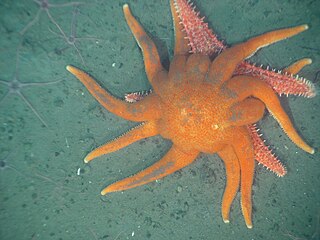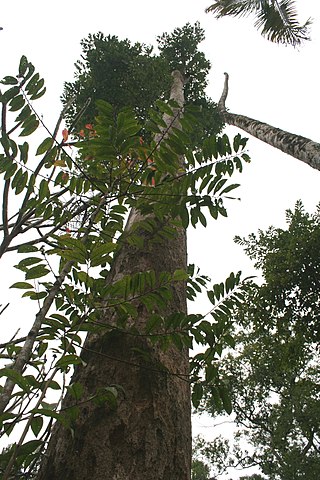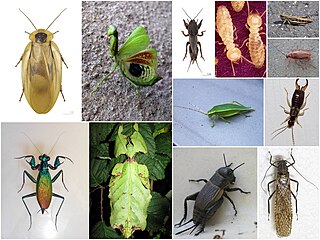
Kalanchoe, also written Kalanchöe or Kalanchoë, is a genus of about 125 species of tropical, succulent plants in the stonecrop family Crassulaceae, mainly native to Madagascar and tropical Africa. A Kalanchoe species was one of the first plants to be sent into space, sent on a resupply to the Soviet Salyut 1 space station in 1979. The majority of kalanchoes require around 6–8 hours of sunlight a day; a few cannot tolerate this, and survive with bright, indirect sunlight to bright shade.

The Valvatida are an order of starfish in the class Asteroidea, which contains 695 species in 172 genera in 17 families.

Evarcha is a genus of spiders in the family Salticidae with 85 species distributed across the world.

Stenaelurillus is a genus of jumping spiders that was first described by Eugène Louis Simon in 1886. Most species live in Africa, with some species found in Asia, including China. All species have two white longitudinal stripes on the carapace, and both sexes show strong bristles around the eyes. The name is a combination of the Greek sten- "narrow" and the salticid genus Aelurillus.

Petaurista is a genus of rodent in the family Sciuridae. They are large to very large flying squirrels found in forests and other wooded habitats in southern and eastern Asia.

The Bonin flying fox, Bonin fruit bat, or in Japanese Ogasawara giant bat is a species of flying fox in the family Pteropodidae. It is endemic to four islands in Ogasawara Islands, Japan. Its natural habitat is subtropical forests. It is threatened by habitat loss.
Heliciopsis is a genus of about thirteen species of trees, constituting part of the flowering plant family Proteaceae. They grow naturally in Burma, Indo-China, SE. China, Thailand, Peninsular Malaysia, Borneo, Sumatra, Java (Indonesia) and the Philippines. The name means similar to the plant genus Helicia. Its closest relatives are Athertonia (Australia) and Virotia.

Madhuca is a genus of plants in the family Sapotaceae first described as a genus in 1791.

Acanthocephalus is a genus of parasitic worms. One of the species in this genus is Acanthocephalus anguillae, a fish parasite. Acanthocephalans are also found in humans and primates, causing a common zoonotic infection called "human acanthocephaliasis". While pathogens can be transferred among animals and humans, the main source of human acanthocephaliasis is the diet of infected raw fish and insects. Because they are lacking circulatory, respiratory, and digestive systems, Acanthocephalus are exceptionally well-adapted to a symbiotrophic existence.

The Euryalida are an order of brittle stars, which includes large species with either branching arms or long and curling arms.

Bolidophyceae is a class of photosynthetic heterokont picophytoplankton, and consist of less than 20 known species. They are distinguished by the angle of flagellar insertion and swimming patterns as well as recent molecular analyses. Bolidophyceae is the sister taxon to the diatoms (Bacillariophyceae). They lack the characteristic theca of the diatoms, and have been proposed as an intermediate group between the diatoms and all other heterokonts.

Miodentosaurus is a genus of thalattosaurian from the Late Triassic of China. It is one of several thalattosaurs found in the Xiaowa Formation, also known as the Wayao Member of the Falang Formation. The genus name "Miodentosaurus" translates to "Few toothed-lizard" while the species name "brevis" means "short", in reference to its short snout.

Andrias is a genus of giant salamanders. It includes the largest salamanders in the world, with A. japonicus reaching a length of 1.44 metres, and A. sligoi reaching 1.80 metres. While extant species are only known from East Asia, several extinct species in the genus are known from late Oligocene and Neogene aged fossils collected in Europe and North America, indicating that the genus formerly had a much wider range.

The Palawan bearded pig is a pig species in the genus Sus endemic to the Philippines, where it occurs on the archipelago of islands formed by Balabac, Palawan, and the Calamian Islands. It is 1 to 1.6 m in length, about 1 m (3.3 ft) tall and weigh up to 150 kg (330 lb).

Henricia is a large genus of slender-armed sea stars belonging to the family Echinasteridae. It contains about fifty species.

Metagonimus yokogawai, or the Yokogawa fluke, is a species of a trematode, or fluke worm, in the family Heterophyidae.

The cohort Polyneoptera is one of the major groups of winged insects, comprising the Orthoptera and all other neopteran insects believed to be more closely related to Orthoptera than to any other insect orders. They were formerly grouped together with the Palaeoptera and Paraneoptera as the Hemimetabola or Exopterygota on the grounds that they have no metamorphosis, the wings gradually developing externally throughout the nymphal stages. Many members of the group have leathery forewings (tegmina) and hindwings with an enlarged anal field (vannus).
Mentha japonica is a plant species in the genus Mentha, endemic to the islands of Hokkaido and Honshu, Japan. Initially described as Micromeria japonica by Friedrich Anton Wilhelm Miquel, it was first identified under its present name by Japanese botanist Tomitaro Makino in 1906. A relatively rare plant, it is classified by the Japanese Ministry of Environment as a Near Threatened species.
Hamacantha is a genus of sponges in the family Hamacanthidae. This species in this genus differ from those in the other genera in this family through the presence of diancistras, distinctive microscleres. These are thought to aid in framing the skeleton by joining monactine megascleres. This genus contains 30 species in three subgenera.
Metabronema is a genus of nematodes belonging to the family Cystidicolidae.















